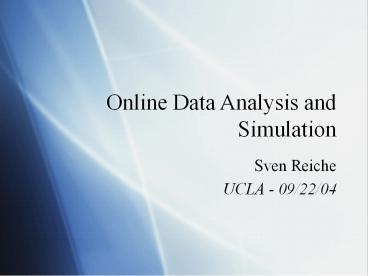Online Data Analysis and Simulation - PowerPoint PPT Presentation
Title:
Online Data Analysis and Simulation
Description:
Integrated analysis software (e.g. emittance measurement) ... Data conversions modules. Scripting environment. Hardware resources. Basic Set-up ... – PowerPoint PPT presentation
Number of Views:68
Avg rating:3.0/5.0
Title: Online Data Analysis and Simulation
1
Online Data Analysis and Simulation
- Sven Reiche
- UCLA - 09/22/04
2
Goals
- Help operators in commissioning the machine.
- Essential for semi-automated procedures (e.g.
BBA). - Confirm (or reject) certain models for beam
propagation. - Complete understanding of the machine, required
for further modification/upgrades.
3
Requirements
- Database of machine settings and diagnostic
- Integrated analysis software (e.g. emittance
measurement) - Core simulation suite (Parmela/Astra, Elegant,
Genesis/Ginger) - Data conversions modules
- Scripting environment
- Hardware resources
4
Basic Set-up
Machine/Experiment
Input for Simulation
Change Settings
Diagnostic/ Measurement
Derived Beam Model
Comparison (Operator)
Derived Measurement
Complete Beam Model
Update Model
Start-end Simulation
5
Online Data Analysis
- Goal to model the electron beam or to confirm an
existing model. - Direct and calibrated measurements (Charge, RF
Phases etc). - Programs to extract information (e.g. emittance
from quad scan or tomography). - Stores information in database.
- Requires eventually to automate control of the
machine.
6
Online Simulation
- Simulation, based on machine set-values and/or
experimental beam model. - Reproduction of existing measurement (e.g. beam
profiles at OTR screens). - Comparison with experimentally derived beam
information. - Interface with machine set-value and/or
experimental results.
7
Injector
- Fast calculation of beam envelope (HOMDYN,
Trace3D) or more time-consuming Particle Tracking
(PARMELA, Astra). - Depends critical of the underlying model (e.g.
thermal emittance) and injector settings (e.g.
solenoid field, rf phase). - Weak/non-existing interface to drive laser
(import profile of virtual cathode into the
codes).
8
Linac
- ELEGANT as solely choice for Linac simulation.
- Execution of 3D CSR calculation (Traffic4,
CSRTrack) too time consuming for
online-simulation. - Because simulation depends on various machine
set-values, automated interface with database is
essential.
9
Undulator/FEL
- No dynamic machine parameters (undulator lattice
only). - Requires a detailed model of the electron beam.
- Calculation varies from minutes (FEL amplifier
model) to days (full bunch SASE simulation). - Background signal from spontaneous radiation not
negligible.
10
Realization I
- Extension of established start-end simulation by
automated interface between codes and/or machine
database. - Support by the code authors is essential.
- Codes and code-interface programs should be
scriptable or callable by a programming
environment (e.g. Matlab). Simplest form of
system calls (e.g. system in C/C or spawn
in IDL) should be sufficient.
11
Realization II
- Interface to database for machine set-values
(dynamic parameters) and machine parameters
(static parameters). - Postprocessing of simulation output is written
back to database or handed over to next code
(agreement on format essential). - For commissioning the postprocessor should mimic
diagnostic for better comparison.
12
Simplification for Operation
- No particle tracking for Injector
- No CSR codes for Linac tracking
- FEL Amplifier model only for time-dependent runs
- Far-field approximation for calculation of the
spontaneous background - Piecewise calculation (no single-button start-end
simulation)
13
Conclusion
- Diagnostic has to be defined so that codes can
model the equivalent virtual LCLS. - Automation between codes is straight forward if
support by authors exists. - Embedded in an easy to program environment
(Matlab). - Online simulation have to be fast to support the
operation of the machine and not the data
analysis.































